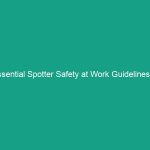Introduction
In the oil and gas industry, where the stakes are high, ensuring the health and Safety of contractors is paramount. Contractor Safety Management in the Oil and Gas Industry is not just a regulatory requirement; it is a critical component of operational efficiency and risk mitigation. The nature of this industry involves complex processes, hazardous materials, and rigorous safety protocols. Thus, effective safety management systems must be in place to protect the workforce and the Environment.
The importance of Workplace Safety cannot be understated. It not only safeguards the lives of workers but also preserves the integrity of operations and the environment. By systematically managing contractor safety, companies can significantly reduce incidents and accidents, thereby enhancing their reputation and operational performance. This article provides an in-depth look at the essential tips for managing contractor safety effectively within the oil and gas sector.
Understanding Regulatory Frameworks
Regulatory frameworks play a crucial role in shaping Contractor Safety Management in the Oil and Gas Industry. Governments and international bodies establish Regulations to ensure Safe Practices, protect workers, and minimize environmental impact.
Key Legislation and Standards
In most countries, the oil and gas sector is governed by a complex web of regulations. For instance, in the United States, the Occupational Safety and Health Administration (OSHA) sets and enforces standards for Workplace Safety. Key regulations include:
- osha‘s General Industry Standards: These standards provide guidelines for various workplace Hazards.
- Environmental Protection Agency (EPA) Regulations: These regulations focus on environmental protection during oil and gas operations.
- International Organization for Standardization (ISO) Standards: ISO 45001 specifies requirements for Occupational Health and safety management systems.
Understanding these regulations is essential for organizations to ensure compliance and avoid legal repercussions. It is also vital for contractors to be aware of these standards to align their practices accordingly.
Compliance and Auditing
Regular compliance checks and audits can help maintain safety standards and identify areas for improvement. Companies should conduct thorough audits of their contractor safety management practices and ensure that all personnel are trained and aware of relevant regulations. This proactive approach not only helps in mitigating risks but also reinforces the culture of safety within the organization.
Best Practices for Contractor Safety Management
Implementing Best Practices is essential for effective Contractor Safety Management in the Oil and Gas Industry. These practices not only foster a safe working environment but also enhance productivity and employee morale.
Prequalification and Selection of Contractors
Before engaging contractors, it is critical to establish a robust prequalification process. This process should assess the contractor’s safety record, training programs, and compliance with regulations. Factors to consider include:
- Previous safety performance and incident history.
- Safety Training and certifications of personnel.
- Understanding of relevant regulations and standards.
By selecting contractors with a proven commitment to safety, companies can mitigate potential risks and enhance overall safety performance on site.
Training and Awareness Programs
Ongoing training is vital for maintaining high safety standards. Companies should develop comprehensive training programs tailored to the specific needs of their contractors. These programs should cover:
- Safety Procedures and protocols relevant to the work being performed.
- Emergency response plans and Evacuation Procedures.
- Proper use of Personal Protective Equipment (PPE).
Regular refresher courses and drills can help reinforce this training, ensuring that all personnel are prepared to respond effectively in emergency situations.
Communication and Collaboration
Effective communication is the backbone of successful Contractor Safety Management. Establishing clear communication channels between contractors and company personnel fosters collaboration and ensures that safety concerns are promptly addressed. Regular safety meetings and Toolbox Talks can facilitate open discussions about potential Hazards and share Best Practices.
Incident Reporting and Investigation
Establishing a transparent incident reporting system is crucial. All incidents, near misses, and unsafe conditions should be reported and investigated thoroughly. This process helps identify root causes and develop corrective actions to prevent recurrence. Implementing a ‘no blame’ culture encourages workers to report incidents without fear, leading to continuous improvement in safety practices.
Challenges in Contractor Safety Management
Despite the best efforts, organizations often face challenges in managing contractor safety effectively. Recognizing these challenges is the first step toward addressing them and improving safety management practices.
Cultural Differences
In the oil and gas industry, contractors may come from diverse cultural backgrounds, each with its own attitudes toward safety. These cultural differences can lead to misunderstandings and inconsistencies in safety practices. To overcome this challenge, companies must foster a unified safety culture that emphasizes the importance of safety across all levels of the organization.
Supply Chain Complexity
The oil and gas sector often involves a complex supply chain with multiple contractors and subcontractors. This complexity can lead to gaps in safety oversight. To mitigate this risk, organizations should establish clear lines of responsibility and accountability for safety management throughout the supply chain.
Resource Constraints
Limited resources can hinder the implementation of effective safety programs. Companies must prioritize safety investments and allocate adequate resources for training, equipment, and safety personnel. Demonstrating the return on investment for safety initiatives can help garner support from management and secure necessary funding.
Case Studies: Success Stories in Contractor Safety Management
Learning from successful implementations of Contractor Safety Management in the Oil and Gas Industry can provide valuable insights and practical examples for other organizations.
Case Study 1: A Leading Oil Company
One of the world’s leading oil companies faced challenges with contractor safety management due to a high rate of incidents. The company implemented a comprehensive contractor safety management system that included rigorous prequalification, enhanced training programs, and regular audits. As a result, the incident rate fell by over 40% within two years, demonstrating the effectiveness of proactive safety management.
Case Study 2: Offshore Drilling Operations
An offshore drilling company encountered significant safety issues due to diverse contractor teams working simultaneously. By introducing a unified safety management approach, including standardized training and regular safety briefings, the company improved communication and collaboration among teams. This led to a marked decrease in incidents and improved overall safety performance on site.
Future Trends in Contractor Safety Management
The landscape of Contractor Safety Management in the Oil and Gas Industry is continuously evolving. Staying informed about future trends can help organizations adapt and enhance their safety practices.
Technology Integration
Advancements in technology are transforming how safety is managed in the oil and gas sector. Digital tools such as mobile applications for incident reporting, drones for site inspections, and data analytics for risk assessment are becoming increasingly prevalent. These technologies can streamline safety management processes and enhance real-time monitoring of safety compliance.
Focus on Mental Health and Well-being
The importance of mental health in the workplace is gaining recognition. Organizations are beginning to understand that mental well-being is integral to overall safety performance. Implementing programs that support mental health can contribute to a more resilient workforce, reducing the likelihood of accidents and enhancing productivity.
Collaboration Across Industries
As safety challenges become more complex, collaboration across industries is becoming essential. Sharing best practices and lessons learned can foster innovation in safety management. Engaging in industry forums and partnerships can facilitate knowledge sharing and drive improvements in safety standards.
Conclusion
Effective Contractor Safety Management in the Oil and Gas Industry is essential for protecting workers, the environment, and the organization’s reputation. By understanding regulatory frameworks, implementing best practices, addressing challenges, and learning from case studies, organizations can enhance their safety performance. The future of contractor safety management will undoubtedly be shaped by technology, a focus on mental health, and collaboration across sectors.
As we move forward, it is crucial for all stakeholders in the oil and gas industry to prioritize safety and continuously seek improvement. By fostering a culture of safety and investing in effective management practices, we can ensure a safer working environment for everyone involved. Join the effort to enhance contractor safety management and contribute to a safer oil and gas industry.


